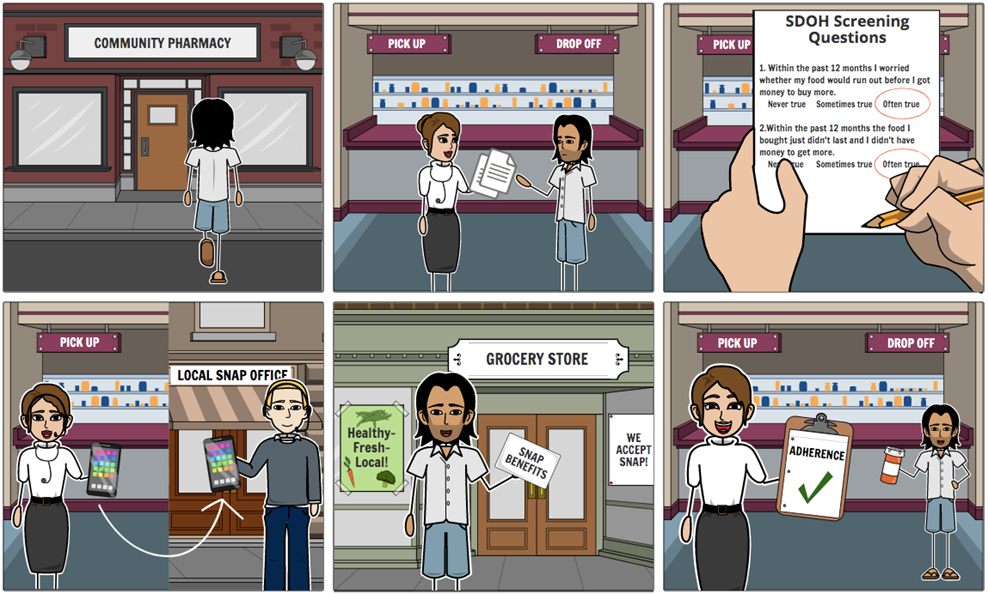By: Emily Ruiz Escobar
Our healthcare system has casually been described as a “sick care system” because it usually cares for people only after they are already sick. Medical care delivered in healthcare settings alone has a limited effect on the health of individuals and populations. In fact, medical care is responsible for only up to 20% of a health outcome while the rest is attributable to social determinants of health (SDOH) — health-related behaviors, socioeconomic factors, and environmental factors that are shaped by the conditions in which we grow, learn, work, and live.4 So, it is no surprise that unmet social needs such as food insecurity, housing instability, and unemployment are associated with poor patient adherence to medications and poor health outcomes.1–3 For more information on SDOH and its role in health, visit our previous blog titled, “An Unlikely Connection—How Transportation Affects Health”.
Investigators at CMO have started exploring avenues for incorporating SDOH in healthcare delivery with the larger goal of facilitating SDOH-targeted interventions in pharmacy practice. With this goal in mind, CMO investigators first reviewed existing screening tools for assessing patients for unmet social needs in healthcare settings. As a result, a validated screening toolkit was created, which is readily accessible to all healthcare professionals looking to screen and identify social barriers to patient health. Next, investigators turned their attention toward existing care models that use such screening tools to first identify and then address unmet social needs as an important part of healthcare delivery. For example, is there a primary care clinic that is screening for food insecurity, referring people to a local food bank or SNAP office, and tracking referrals? If so, what do these referrals and outcomes look like? A report summarizing such care models can be found here.
The community care models summarized in the report above have been implemented in a wide range of settings (e.g., hospitals, pediatric clinics, community health centers, and primary care clinics), but none have been found in pharmacy practice settings. Since pharmacists play an important role in the delivery of many health services, including primary care,5 it is essential to investigate how pharmacists can get involved in addressing SDOH. So, what can pharmacists do to contribute? What would this look like? Consider the illustration of SDOH screening and referral at a community pharmacy in Figure 1 below.
Fig. 1. A promising scenario: SDOH screening and referral at a community pharmacy.
Image created by Emily Ruiz Escobar using Storyboard That (https://www.storyboardthat.com).
The above illustration demonstrates the potential impact of identifying and addressing social needs among patients if such initiatives are widely employed and integrated into the delivery of healthcare services, including services offered at community pharmacies.
Although there is no single solution to addressing unmet social needs during the delivery of healthcare services, we can facilitate community collaboration and support networks that will better address complex SDOH. The CMO team is excited to continue exploring what these collaborations between healthcare professionals, community organizations, and patients will look like, and we plan to release more information on further investigations in this area soon.
References
- Kardas P, Lewek P, Matyjaszczyk M. Determinants of patient adherence: A review of systematic reviews. Front Pharmacol. 2013. doi:10.3389/fphar.2013.00091
- Mathes T, Jaschinski T, Pieper D. Adherence influencing factors – a systematic review of systematic reviews. Arch Public Heal. 2014. doi:10.1186/2049-3258-72-37
- Hood CM, Gennuso KP, Swain GR, Catlin BB. County Health Rankings: Relationships between Determinant Factors and Health Outcomes. Am J Prev Med. 2016;50(2):129-135. doi:10.1016/j.amepre.2015.08.024
- Magnan S. Social Determinants of Health 101 for Health Care: Five Plus Five. NAM Perspect. 2017. doi:10.31478/201710c
- National Association of Drug Stores. Re: Health Care Workshop, Project No. P131207.

